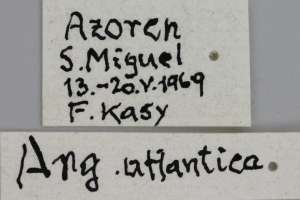

 +1Kontinente:EU
+1Kontinente:EU



2. Diagnose
2.1. Geschlecht nicht bestimmt
2.2. Erstbeschreibung
2.3. Beschreibung als Argyresthia minusculella
2.4. Beschreibung als Tinea poecilella
3. Biologie
3.1. Nahrung der Raupe
- [Myricaceae:] Myrica faya (Gagelbaum)
- [Ericaceae:] Erica scoparia ssp. azorica (Azoren-Heidekraut)
- [Ericaceae:] Vaccinium cylindraceum (Azoren-Heidelbeere)
Silva et al. (1995) fragen sich, ob die Art zur Bekämpfung der nach Hawaii eingeschleppten Myrica faya dienen könnte. Sie stellen fest: "Larvae develop on M. faya male flowers and green fruits from April until August, and have the potential to decrease seed set. In the 1990's, field studies showed that A. atlanticella was also associated with Erica scoparia ssp. azorica and Vaccinium cylindraceum (Ericaceae). Adults and larvae were found associated with E. scoparia ssp. azorica throughout the year."
4. Weitere Informationen
4.1. Synonyme
- Argyresthia minusculella Rebel, 1940 [synonymisiert durch Pérez Santa-Rita et al. (2020)]
- Tinea poecilella Rebel, 1940 [synonymisiert durch Pérez Santa-Rita et al. (2020)]
- Argyresthia poecilella (Rebel, 1940) [synonymisiert durch Pérez Santa-Rita et al. (2020)]
4.2. Taxonomie
Rebel (1940) beschrieb gleich 2 Argyresthia-Arten von den Azoren, A. atlanticella und A. minusculella, außerdem noch "Tinea poecilella". Borges & al. (2018: 187) teilten zur ominösen, nur nach einem schlecht erhaltenen Einzelexemplar beschriebenen "Tinea poecilella" mit: “A study of the holotype shows that it belongs to the genus Argyresthia (O. Karsholt, unpubl.).”
Nach Pérez Santa-Rita et al. (2020) handelt es sich bei den drei Taxa um eine einzige, äußerlich sehr variable Art, Argyresthia atlanticella - die Barcoding-Ergebnisse der drei Taxa überschneiden sich, so dass kaum eine andere Deutung möglich ist. A. atlanticella gehört - genetisch gesehen - in die nächste Verwandschaft der Argyresthia semifusca und damit in die Untergattung Argyresthia. Überraschend fanden sie bei ihrer Untersuchung der Gattung auf den Azoren aber auch Exemplare einer bisher noch unbeschriebenen Art aus dem genetischen Umfeld von Argyresthia trifasciata, also aus der Untergattung Blastotere. Diese wurde dann als Argyresthia brumella beschrieben.
4.3. Faunistik
Die Art ist ein Endemit der Azoren und dort eine der wenigen häufigeren Schmetterlingsarten.
(Autor: Erwin Rennwald)
4.4. Literatur
- Borges, P. A. V., Santa-Rita, J. V., Nunes, R., Danielczak, A., Hochkirch, A., Amorim, I. R., Lamelas-Lopez, L., Karsholt, O. & V. Vieira (2018): Species conservation profile of moths (Insecta, Lepidoptera) from Azores, Portugal. — Biodiversity Data Journal 6: 1-201 [PDF auf researchgate.net].
- Pérez Santa-Rita, J.V., Baixeras, J. & O. Karsholt (2020): The enigmatic case of the genus Argyresthia in the Azores Islands (Lepidoptera: Argyresthiidae). — Zootaxa, 4789 (1): 217–232.
- Erstbeschreibung und Beschreibung als Argyresthia minusculella und Tinea poecilella: Rebel, H. (1940): Die Lepidopterenfauna des Azorischen Archipels. — Commentationes Biologicae 8 (1): 1-59, pl. I-II.
- Silva, L., G. Markin & J. Tavares (1995): Argyresthia atlanticella Rebel (Insecta: Lepidoptera) an excluded agent for Myrica faya Aiton (Myricaceae) biocontrol. — Arquipelago. Life and Marine Sciences 13A: 105-113. [PDF auf repositorio.uac.pt]









